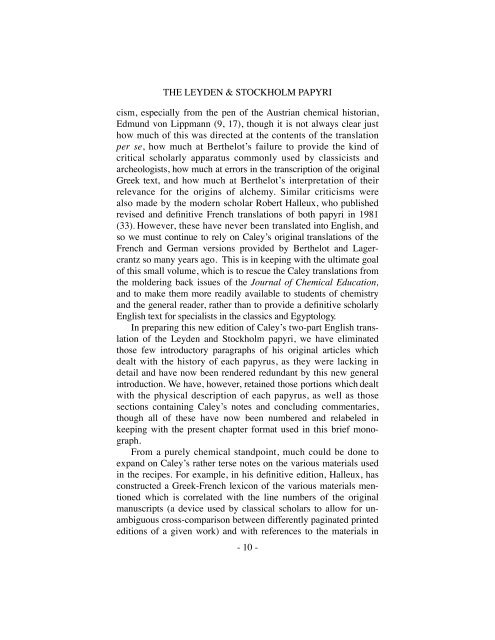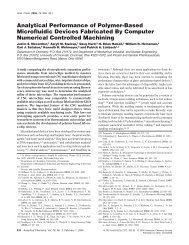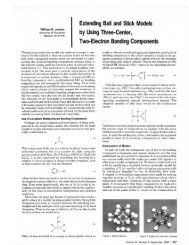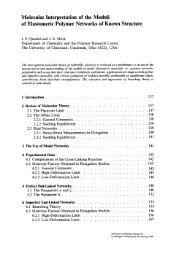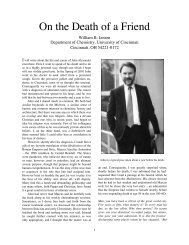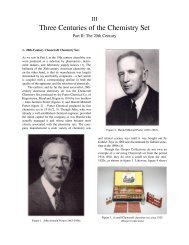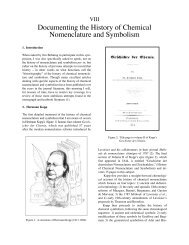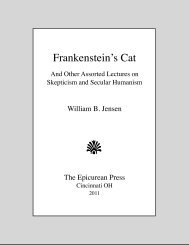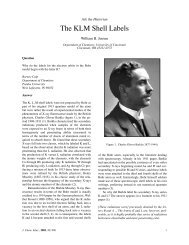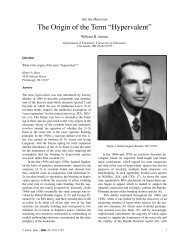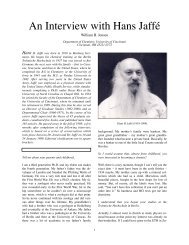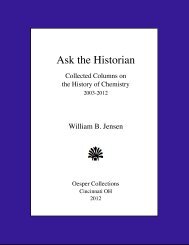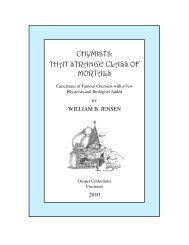The Leyden and Stockholm Papyri - University of Cincinnati
The Leyden and Stockholm Papyri - University of Cincinnati
The Leyden and Stockholm Papyri - University of Cincinnati
You also want an ePaper? Increase the reach of your titles
YUMPU automatically turns print PDFs into web optimized ePapers that Google loves.
THE LEYDEN & STOCKHOLM PAPYRI<br />
cism, especially from the pen <strong>of</strong> the Austrian chemical historian,<br />
Edmund von Lippmann (9, 17), though it is not always clear just<br />
how much <strong>of</strong> this was directed at the contents <strong>of</strong> the translation<br />
per se, how much at Berthelot’s failure to provide the kind <strong>of</strong><br />
critical scholarly apparatus commonly used by classicists <strong>and</strong><br />
archeologists, how much at errors in the transcription <strong>of</strong> the original<br />
Greek text, <strong>and</strong> how much at Berthelot’s interpretation <strong>of</strong> their<br />
relevance for the origins <strong>of</strong> alchemy. Similar criticisms were<br />
also made by the modern scholar Robert Halleux, who published<br />
revised <strong>and</strong> definitive French translations <strong>of</strong> both papyri in 1981<br />
(33). However, these have never been translated into English, <strong>and</strong><br />
so we must continue to rely on Caley’s original translations <strong>of</strong> the<br />
French <strong>and</strong> German versions provided by Berthelot <strong>and</strong> Lagercrantz<br />
so many years ago. This is in keeping with the ultimate goal<br />
<strong>of</strong> this small volume, which is to rescue the Caley translations from<br />
the moldering back issues <strong>of</strong> the Journal <strong>of</strong> Chemical Education,<br />
<strong>and</strong> to make them more readily available to students <strong>of</strong> chemistry<br />
<strong>and</strong> the general reader, rather than to provide a definitive scholarly<br />
English text for specialists in the classics <strong>and</strong> Egyptology.<br />
! In preparing this new edition <strong>of</strong> Caley’s two-part English translation<br />
<strong>of</strong> the <strong>Leyden</strong> <strong>and</strong> <strong>Stockholm</strong> papyri, we have eliminated<br />
those few introductory paragraphs <strong>of</strong> his original articles which<br />
dealt with the history <strong>of</strong> each papyrus, as they were lacking in<br />
detail <strong>and</strong> have now been rendered redundant by this new general<br />
introduction. We have, however, retained those portions which dealt<br />
with the physical description <strong>of</strong> each papyrus, as well as those<br />
sections containing Caley’s notes <strong>and</strong> concluding commentaries,<br />
though all <strong>of</strong> these have now been numbered <strong>and</strong> relabeled in<br />
keeping with the present chapter format used in this brief monograph.<br />
! From a purely chemical st<strong>and</strong>point, much could be done to<br />
exp<strong>and</strong> on Caley’s rather terse notes on the various materials used<br />
in the recipes. For example, in his definitive edition, Halleux, has<br />
constructed a Greek-French lexicon <strong>of</strong> the various materials mentioned<br />
which is correlated with the line numbers <strong>of</strong> the original<br />
manuscripts (a device used by classical scholars to allow for unambiguous<br />
cross-comparison between differently paginated printed<br />
editions <strong>of</strong> a given work) <strong>and</strong> with references to the materials in<br />
- 10 -


